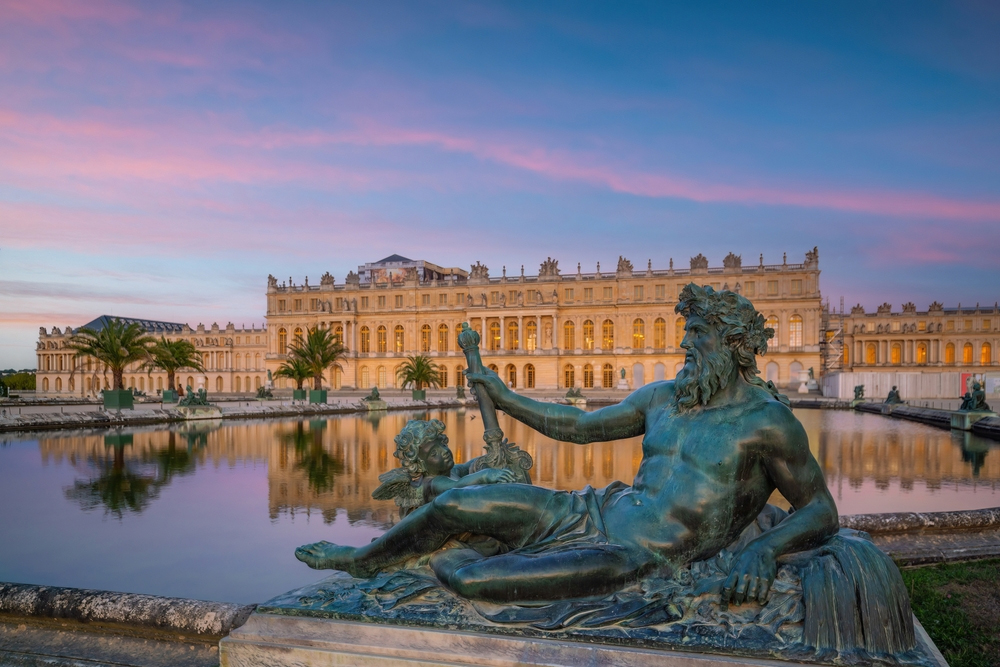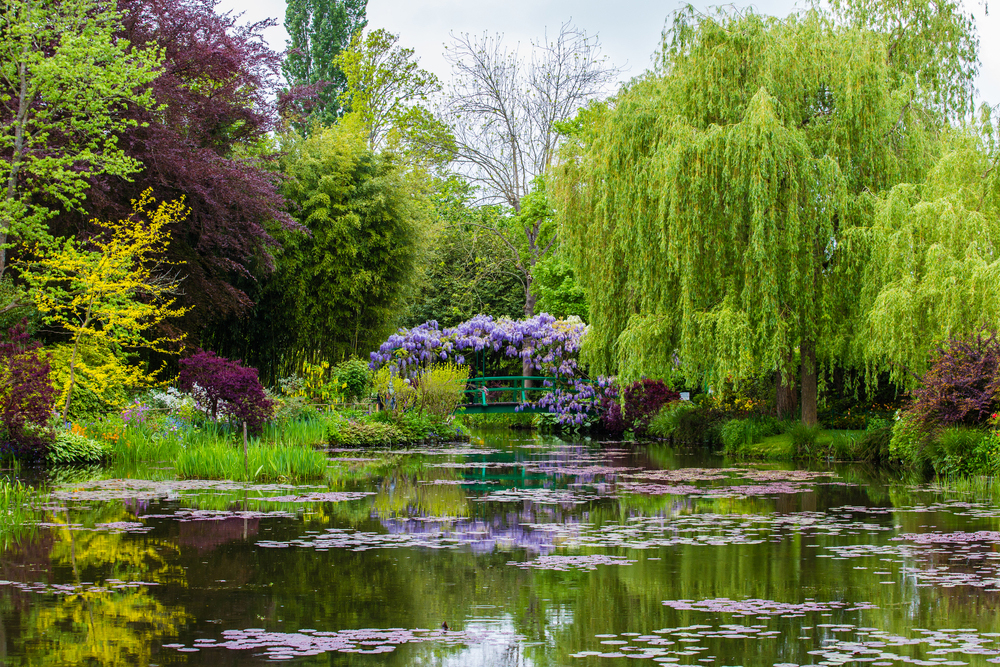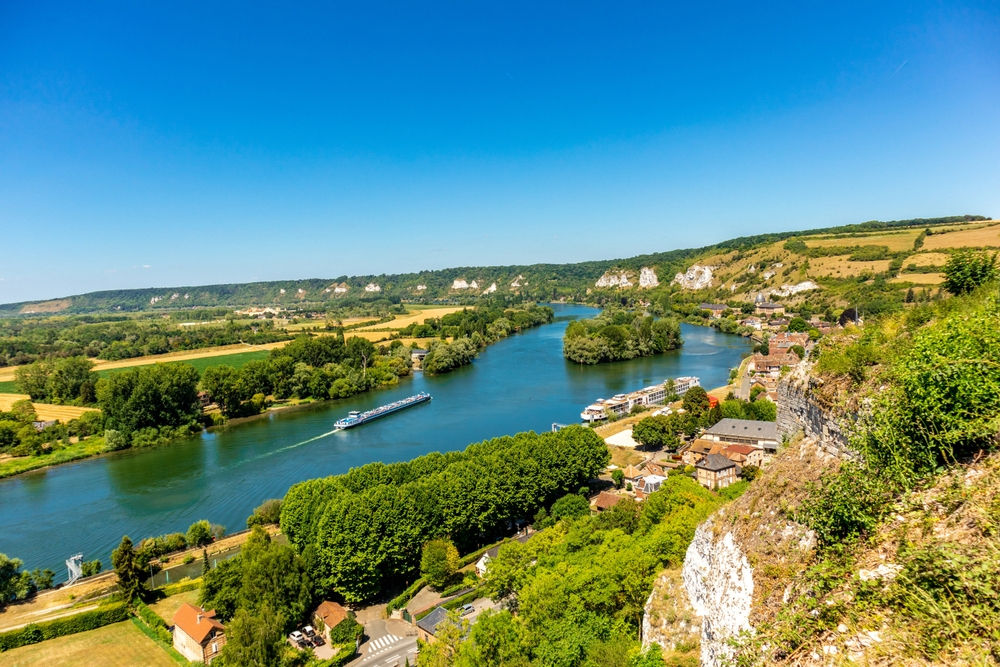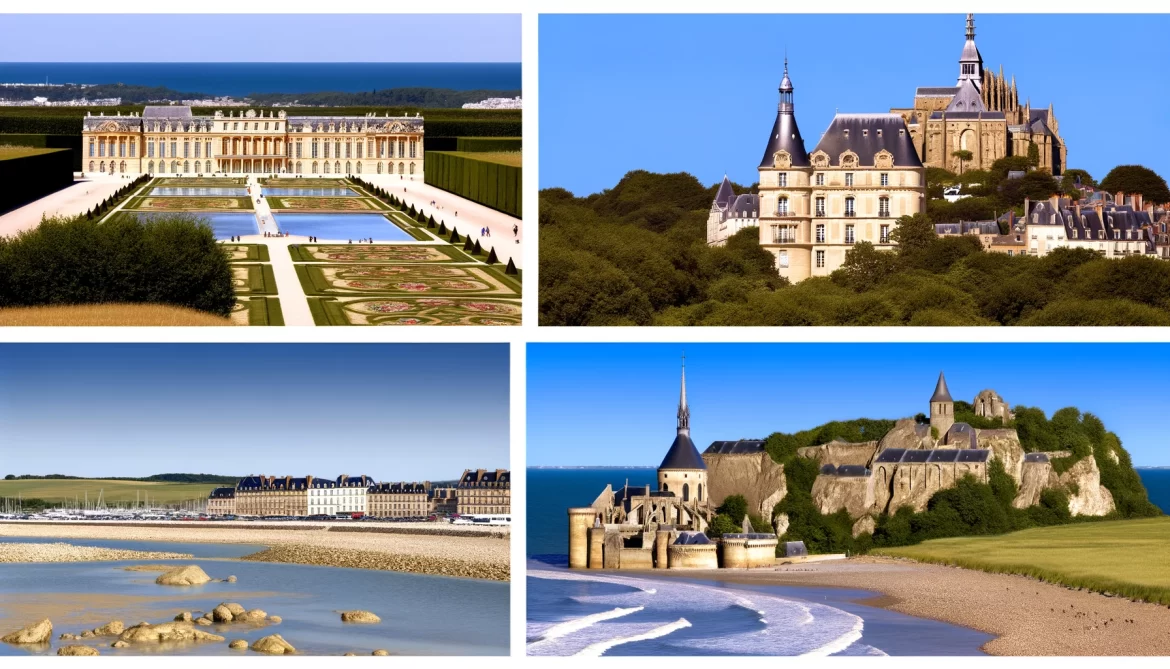Exploring Beyond Paris: A Guide to the Best Day Trips
Embarking on day trips from Paris opens up a world of experiences. Whether you’re tracing the steps of royalty at the Chateau de Versailles, wandering through Monet’s idyllic gardens in Giverny, or standing in awe at the architectural marvel of Mont Saint-Michel, each journey brings its own set of wonders.
Chateau de Versailles: A Royal Escape

Garden of Chateau de Versailles, near Paris in France at sunset
The Chateau de Versailles is not just a monument but a grand narrative of France’s royal history, encapsulating the apex of French artistry and architectural grandeur. This magnificent palace, once the epicenter of French power, stands as a testament to the lavish tastes and political ambitions of its most famous inhabitant, King Louis XIV, the Sun King. Today, it serves as a symbol of the country’s rich cultural heritage, drawing visitors from around the globe to marvel at its opulence and beauty.
Nestled just a short journey away from Paris, Versailles is a gateway into the splendor and pomp of the French monarchy. As you step through its gates, you’re transported into a world of unrivaled elegance. The palace itself, with its elaborate facades, intricate decorations, and the iconic Hall of Mirrors, reflects not just the literal light from its many windows and mirrors but also the metaphorical light of its era’s most enlightened monarch.
The gardens of Versailles are no less spectacular, sprawling across 800 hectares and meticulously designed by André Le Nôtre, Louis XIV’s principal gardener. These gardens are a masterclass in symmetry, precision, and grandeur, featuring an array of fountains, groves, and statues that animate the landscape with the mythology and ambition of the Sun King’s reign. The Musical Fountain Shows, where the fountains dance to the tunes of the period, offer a mesmerizing experience that combines the art of sculpture, music, and hydro-engineering.
Beyond the palace and gardens, the Estate of Trianon and the Queen’s Hamlet offer a more intimate glimpse into the lives of the royals. These smaller palaces and rustic retreats were designed as escapes from the rigors of court life, offering a contrasting perspective on the era’s aesthetics and ideals.
Visiting the Chateau de Versailles is not merely about witnessing the grandeur of a bygone era; it’s about understanding the cultural, political, and artistic currents that shaped not just France but the world at large during the reign of its kings. Whether it’s marveling at the intricacies of the Royal Chapel, exploring the King’s Grand Apartments, or taking a stroll through the Orangerie, each corner of Versailles reveals a new layer of the story of France’s grandeur.
For those planning to visit, arriving early to avoid the crowds and wearing comfortable shoes is advisable, as the estate’s vastness demands considerable walking. Additionally, taking a guided tour can enrich your experience, offering insights into the palace’s history, secrets, and the many fascinating stories of its inhabitants.
Giverny: Immersing in Monet’s World

France Giverny Monet’s garden spring May
Mont Saint-Michel: A Medieval Marvel
Champagne Region: A Toast to the Bubbly
The Champagne region, renowned worldwide for its sparkling wine, is a destination that combines the pleasures of taste with the beauty of the French countryside and the richness of historical heritage. Just a short trip from Paris, this region offers an unforgettable journey into the heart of France’s wine country, where the art of winemaking reaches its pinnacle in the effervescent joy of champagne. This area, comprising the towns of Reims, Épernay, and the surrounding vineyard-covered hills, is not only a gastronomic paradise but also a place steeped in history and tradition.
Embarking on a tour of the Champagne region is like stepping into a world where every sip tells a story of craftsmanship, terroir, and centuries-old tradition. The region is home to the most prestigious champagne houses, including Moët & Chandon, Veuve Clicquot, and Dom Pérignon, each offering guided tours that delve into the intricate process of champagne production. From the careful selection of grapes to the intricate method of fermentation, aging, and blending, visitors gain insights into the meticulous care that goes into crafting each bottle.
A visit to the Champagne region is incomplete without exploring the vast cellars where bottles are aged. Carved out of chalk, these cellars provide the perfect conditions for aging champagne, maintaining a constant temperature and humidity level. Walking through these underground labyrinths, surrounded by millions of bottles, is a unique experience that underscores the scale and significance of champagne production in the region.
The region’s heart and soul are not confined to its cellars and vineyards alone. The towns of Reims and Épernay are rich in cultural and architectural heritage, with Reims Cathedral standing as a monument of Gothic art and history. This cathedral, where French kings were once crowned, is adorned with stunning stained glass and intricate sculptures that narrate the medieval Christian world. The Palais du Tau, adjacent to the cathedral, and the Saint-Remi Basilica are also must-visit sites, offering a deeper understanding of the region’s royal and religious history.
Exploring the Champagne region also means immersing oneself in the picturesque landscapes of rolling hills and endless vineyards that define the area. The Route du Champagne offers a scenic drive through quaint villages and past grand estates, with ample opportunities for tasting sessions at local wineries. These tastings not only showcase the variety and complexity of champagne but also offer a chance to meet the winemakers, who share their passion and stories, making each glass more meaningful.
For those interested in the finer nuances of champagne, many wineries and houses conduct workshops and tasting sessions that explore the differences between various types of champagne, including vintage, non-vintage, rosé, and blanc de blancs. These sessions provide a deeper appreciation of the factors that influence the taste and quality of champagne, from the blend of grapes to the length of aging.
The Champagne region offers a feast for the senses, combining the allure of its landscapes, the taste of its world-famous bubbly, and the depth of its historical sites. It’s a place where joy and elegance are found in every glass, and the legacy of craftsmanship is celebrated in every vineyard and cellar. A day trip to this region from Paris is not just a journey through the heart of French wine country; it’s an experience that embodies the spirit of celebration and the art of living that is synonymous with champagne. Whether you’re a connoisseur or a curious traveler, the Champagne region promises an enchanting and enriching adventure that bubbles with the excitement of discovery.
Loire Valley Castles: Journey Through Time
Normandy: Beaches and Battlefields

On the way in the beautiful valley of the Seine at Château Gaillard – Les Andelys – Normandy – France
Fontainebleau offers an escape to nature with its vast forest and the magnificent palace at its heart. The palace, once a hunting lodge for French monarchs, is surrounded by trails that invite exploration and adventure.
Provins: A Medieval Fairytale
Step into the Middle Ages in Provins, where towers, ramparts, and underground passages tell the tale of its past as a prosperous trading town. The town comes alive with medieval shows that transport visitors back in time.
Reims: In the Heart of Champagne
Reims stands at the center of the champagne world, but its heart beats in its Gothic cathedral, a masterpiece of medieval architecture and the coronation site of French kings. The champagne houses that dot the city offer a blend of history and taste.
Strasbourg: A Crossroad of Cultures
Strasbourg’s charm lies in its blend of French and German influences, evident in its architecture, cuisine, and the warm welcome of its people. The cathedral and the picturesque Petite France district are must-visits.
Lille: A Flemish Influence
Lille, with its Flemish roots, boasts a vibrant old town and an impressive collection of fine arts at the Palais des Beaux-Arts. Its lively markets and restaurants offer a taste of the region’s culinary delights.
Rouen: Reliving History
Rouen, where Joan of Arc met her fate, is rich in history and Gothic architecture. The cathedral that Monet painted and the old market square offer glimpses into its storied past.
Auvers-sur-Oise: Following Van Gogh’s Footsteps
In Auvers-sur-Oise, visitors can walk in the footsteps of Vincent van Gogh during the last days of his life. The Auberge Ravoux, his final home, and the landscapes that inspired his final works offer a poignant look at the artist’s world.
Disneyland Paris: A Magical Getaway
For families or those young at heart, Disneyland Paris offers a day of adventure and magic. Planning your visit can help maximize the joy of exploring its lands and meeting beloved characters.
Conclusion: Making the Most of Your Day Trips
The best day trips from Paris offer a mosaic of experiences, each enriching the traveler’s journey with history, art, nature, and gastronomy. Whether stepping back in time, exploring natural wonders, or indulging in culinary delights, these excursions promise memories that will last a lifetime.
People Also Ask
Kindly visit:
Also, Don’t forget to check out our YouTube Channel:



